HBS108 Assignment: Dietary Flavonoids and AMD Prevalence Analysis
VerifiedAdded on 2023/06/07
|12
|3001
|296
Homework Assignment
AI Summary
This assignment solution provides a detailed analysis of a research study investigating the relationship between dietary flavonoids and age-related macular degeneration (AMD). It identifies the study design as a Randomized Controlled Trial (RCT) and discusses the independent and dependent variables. The objective of the study, which is to assess the relationship between dietary flavonoid intake and the prevalence and incidence of AMD, is paraphrased. The solution also explores potential biases, such as irregular error and systematic predisposition, and identifies the scale of measurement used in the study. Furthermore, it defines 'incidence' and 'prevalence' in the context of health research and identifies confounding factors controlled for in the study, like age, family history and genetics, and gender. The assignment also interprets odds ratios and confidence intervals related to flavonoid consumption and AMD prevalence, and critiques a media release about the study's findings. Finally, it applies the Bradford-Hill test to assess the possibility of causation between dietary flavonoids and AMD and proposes a suitable study design for future research.

HEALTH SCIENCES
NAME
REG NO
COURSE
Student Name 1
NAME
REG NO
COURSE
Student Name 1
Paraphrase This Document
Need a fresh take? Get an instant paraphrase of this document with our AI Paraphraser
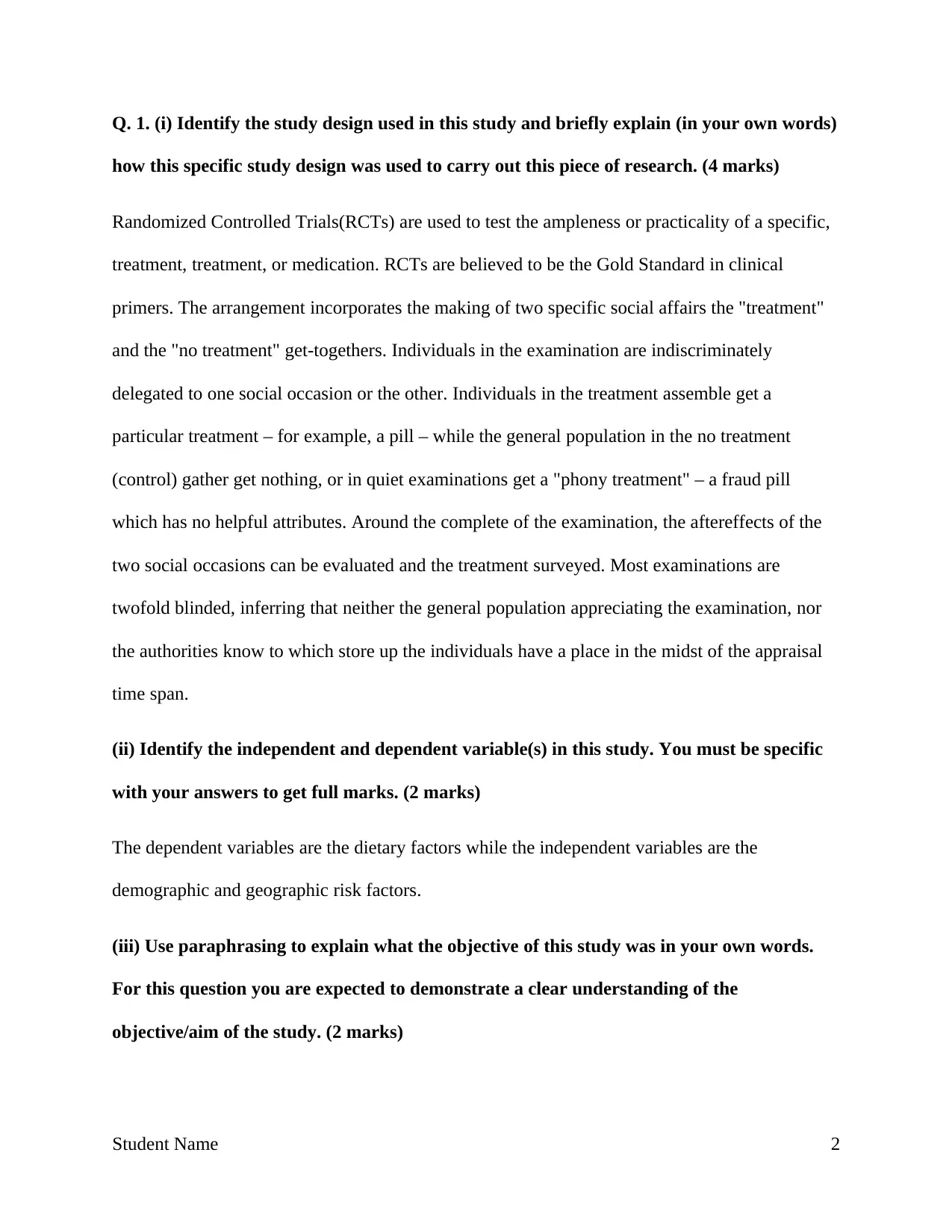
Q. 1. (i) Identify the study design used in this study and briefly explain (in your own words)
how this specific study design was used to carry out this piece of research. (4 marks)
Randomized Controlled Trials(RCTs) are used to test the ampleness or practicality of a specific,
treatment, treatment, or medication. RCTs are believed to be the Gold Standard in clinical
primers. The arrangement incorporates the making of two specific social affairs the "treatment"
and the "no treatment" get-togethers. Individuals in the examination are indiscriminately
delegated to one social occasion or the other. Individuals in the treatment assemble get a
particular treatment – for example, a pill – while the general population in the no treatment
(control) gather get nothing, or in quiet examinations get a "phony treatment" – a fraud pill
which has no helpful attributes. Around the complete of the examination, the aftereffects of the
two social occasions can be evaluated and the treatment surveyed. Most examinations are
twofold blinded, inferring that neither the general population appreciating the examination, nor
the authorities know to which store up the individuals have a place in the midst of the appraisal
time span.
(ii) Identify the independent and dependent variable(s) in this study. You must be specific
with your answers to get full marks. (2 marks)
The dependent variables are the dietary factors while the independent variables are the
demographic and geographic risk factors.
(iii) Use paraphrasing to explain what the objective of this study was in your own words.
For this question you are expected to demonstrate a clear understanding of the
objective/aim of the study. (2 marks)
Student Name 2
how this specific study design was used to carry out this piece of research. (4 marks)
Randomized Controlled Trials(RCTs) are used to test the ampleness or practicality of a specific,
treatment, treatment, or medication. RCTs are believed to be the Gold Standard in clinical
primers. The arrangement incorporates the making of two specific social affairs the "treatment"
and the "no treatment" get-togethers. Individuals in the examination are indiscriminately
delegated to one social occasion or the other. Individuals in the treatment assemble get a
particular treatment – for example, a pill – while the general population in the no treatment
(control) gather get nothing, or in quiet examinations get a "phony treatment" – a fraud pill
which has no helpful attributes. Around the complete of the examination, the aftereffects of the
two social occasions can be evaluated and the treatment surveyed. Most examinations are
twofold blinded, inferring that neither the general population appreciating the examination, nor
the authorities know to which store up the individuals have a place in the midst of the appraisal
time span.
(ii) Identify the independent and dependent variable(s) in this study. You must be specific
with your answers to get full marks. (2 marks)
The dependent variables are the dietary factors while the independent variables are the
demographic and geographic risk factors.
(iii) Use paraphrasing to explain what the objective of this study was in your own words.
For this question you are expected to demonstrate a clear understanding of the
objective/aim of the study. (2 marks)
Student Name 2
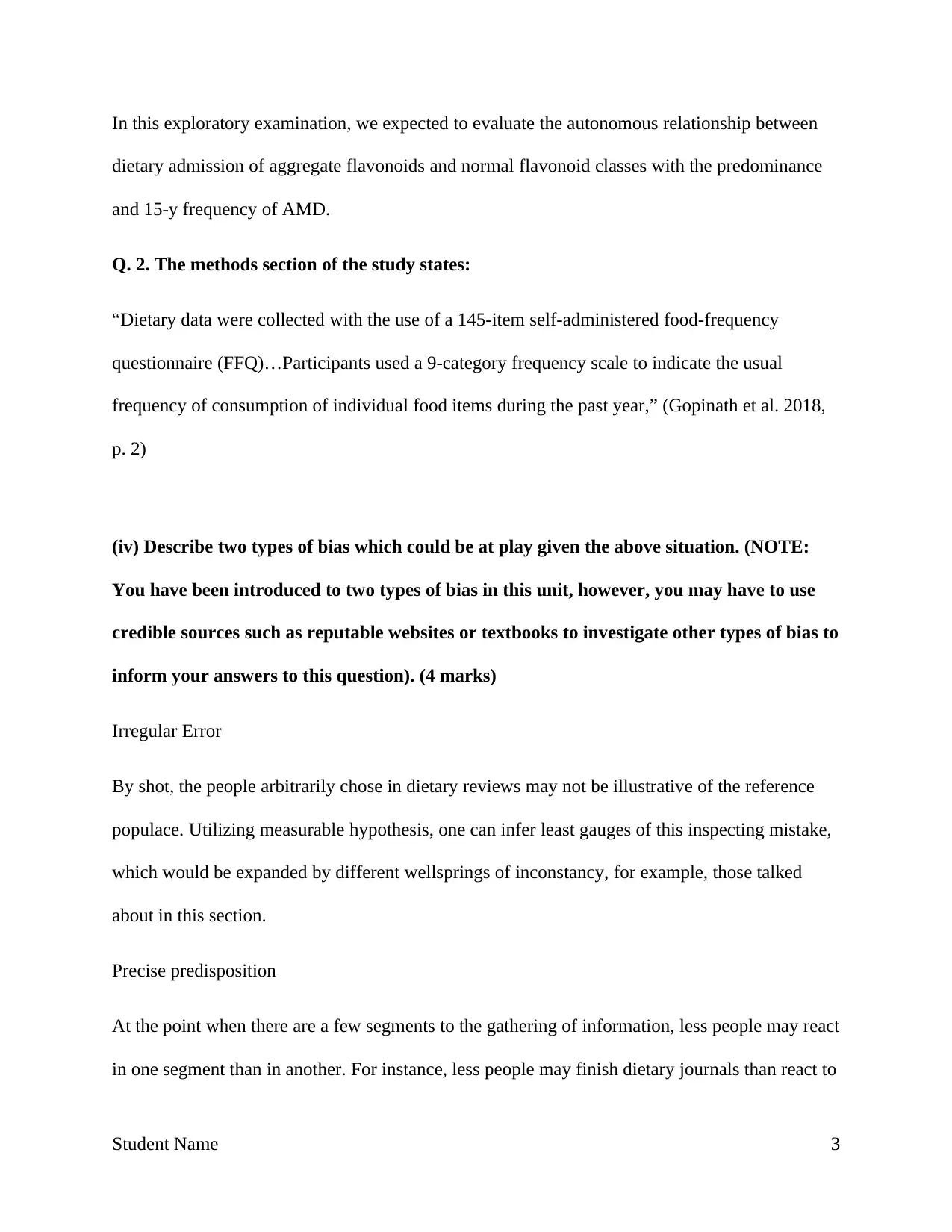
In this exploratory examination, we expected to evaluate the autonomous relationship between
dietary admission of aggregate flavonoids and normal flavonoid classes with the predominance
and 15-y frequency of AMD.
Q. 2. The methods section of the study states:
“Dietary data were collected with the use of a 145-item self-administered food-frequency
questionnaire (FFQ)…Participants used a 9-category frequency scale to indicate the usual
frequency of consumption of individual food items during the past year,” (Gopinath et al. 2018,
p. 2)
(iv) Describe two types of bias which could be at play given the above situation. (NOTE:
You have been introduced to two types of bias in this unit, however, you may have to use
credible sources such as reputable websites or textbooks to investigate other types of bias to
inform your answers to this question). (4 marks)
Irregular Error
By shot, the people arbitrarily chose in dietary reviews may not be illustrative of the reference
populace. Utilizing measurable hypothesis, one can infer least gauges of this inspecting mistake,
which would be expanded by different wellsprings of inconstancy, for example, those talked
about in this section.
Precise predisposition
At the point when there are a few segments to the gathering of information, less people may react
in one segment than in another. For instance, less people may finish dietary journals than react to
Student Name 3
dietary admission of aggregate flavonoids and normal flavonoid classes with the predominance
and 15-y frequency of AMD.
Q. 2. The methods section of the study states:
“Dietary data were collected with the use of a 145-item self-administered food-frequency
questionnaire (FFQ)…Participants used a 9-category frequency scale to indicate the usual
frequency of consumption of individual food items during the past year,” (Gopinath et al. 2018,
p. 2)
(iv) Describe two types of bias which could be at play given the above situation. (NOTE:
You have been introduced to two types of bias in this unit, however, you may have to use
credible sources such as reputable websites or textbooks to investigate other types of bias to
inform your answers to this question). (4 marks)
Irregular Error
By shot, the people arbitrarily chose in dietary reviews may not be illustrative of the reference
populace. Utilizing measurable hypothesis, one can infer least gauges of this inspecting mistake,
which would be expanded by different wellsprings of inconstancy, for example, those talked
about in this section.
Precise predisposition
At the point when there are a few segments to the gathering of information, less people may react
in one segment than in another. For instance, less people may finish dietary journals than react to
Student Name 3
⊘ This is a preview!⊘
Do you want full access?
Subscribe today to unlock all pages.

Trusted by 1+ million students worldwide

a family unit meet. This inclination would be particularly risky if the individuals who finished
journals were preferable composed and better instructed over the individuals who were just met.
(v) Based on what we have learned about scales of measurement in this unit, name the
scale of measurement used by implementing a ‘9-category frequency scale’ and briefly
justify your answer. (2 marks)
Nominal Scale. This scale uses the variable which are placed into categories. The frequency
scale used here classifies it to the nominal scaling.
Q. 3. (i) “In exploratory analyses, we assessed associations with the prevalence and 15-y
incidence of AMD, which were the primary endpoints,” (Gopinath et al. 2018, p.3).
Using credible sources such as reputable websites or textbooks investigate the meaning of the
terms ‘incidence’ and ‘prevalence’ in the context of health research and explain what they mean
in relation to this study regarding AMD. (4 marks)
Predominance alludes to the aggregate number of people in a populace who have an illness or
wellbeing condition at a particular timeframe, generally communicated as a level of the
populace.
Frequency alludes to the quantity of people who build up a particular illness or experience a
particular wellbeing related occasion amid a specific era, (for example, multi month or year).
Student Name 4
journals were preferable composed and better instructed over the individuals who were just met.
(v) Based on what we have learned about scales of measurement in this unit, name the
scale of measurement used by implementing a ‘9-category frequency scale’ and briefly
justify your answer. (2 marks)
Nominal Scale. This scale uses the variable which are placed into categories. The frequency
scale used here classifies it to the nominal scaling.
Q. 3. (i) “In exploratory analyses, we assessed associations with the prevalence and 15-y
incidence of AMD, which were the primary endpoints,” (Gopinath et al. 2018, p.3).
Using credible sources such as reputable websites or textbooks investigate the meaning of the
terms ‘incidence’ and ‘prevalence’ in the context of health research and explain what they mean
in relation to this study regarding AMD. (4 marks)
Predominance alludes to the aggregate number of people in a populace who have an illness or
wellbeing condition at a particular timeframe, generally communicated as a level of the
populace.
Frequency alludes to the quantity of people who build up a particular illness or experience a
particular wellbeing related occasion amid a specific era, (for example, multi month or year).
Student Name 4
Paraphrase This Document
Need a fresh take? Get an instant paraphrase of this document with our AI Paraphraser
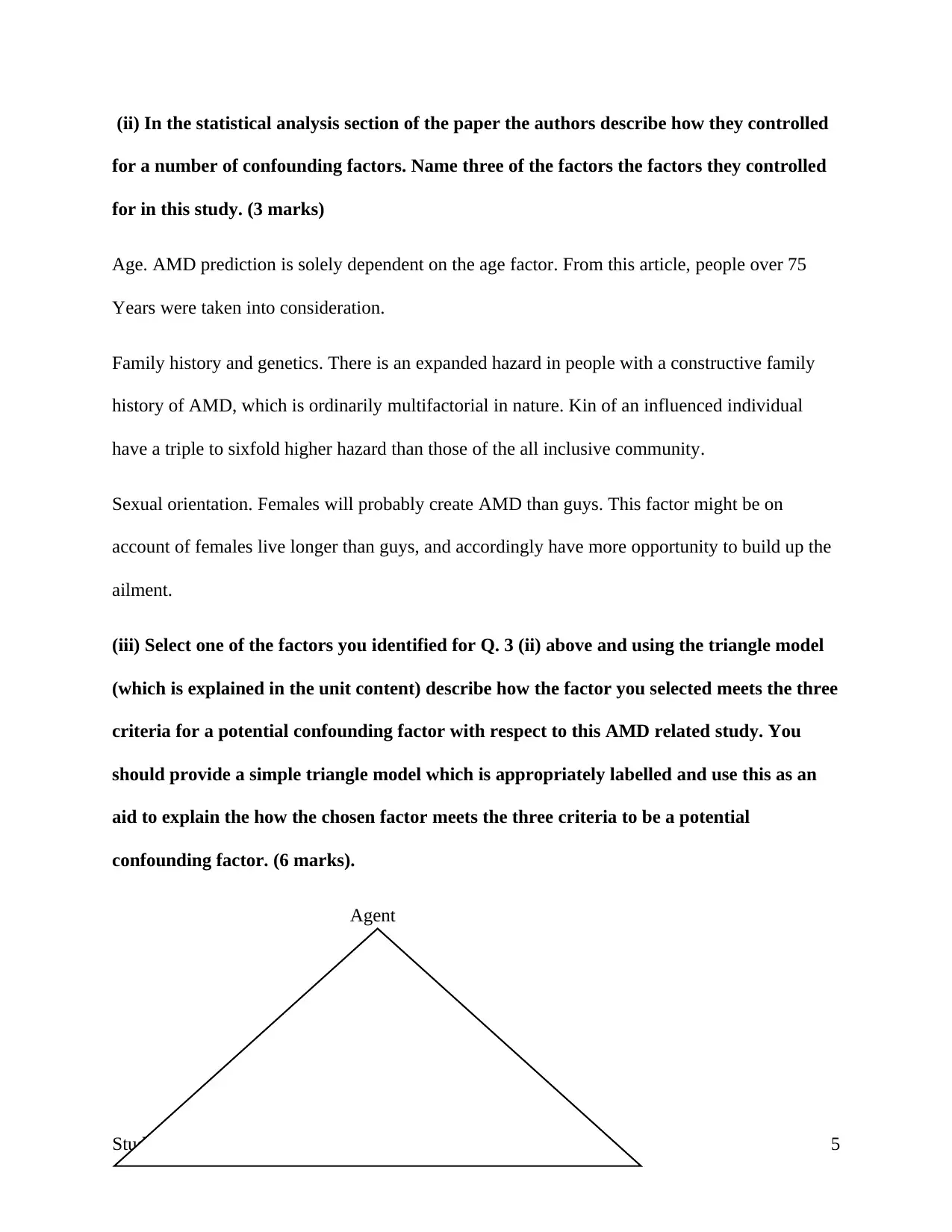
(ii) In the statistical analysis section of the paper the authors describe how they controlled
for a number of confounding factors. Name three of the factors the factors they controlled
for in this study. (3 marks)
Age. AMD prediction is solely dependent on the age factor. From this article, people over 75
Years were taken into consideration.
Family history and genetics. There is an expanded hazard in people with a constructive family
history of AMD, which is ordinarily multifactorial in nature. Kin of an influenced individual
have a triple to sixfold higher hazard than those of the all inclusive community.
Sexual orientation. Females will probably create AMD than guys. This factor might be on
account of females live longer than guys, and accordingly have more opportunity to build up the
ailment.
(iii) Select one of the factors you identified for Q. 3 (ii) above and using the triangle model
(which is explained in the unit content) describe how the factor you selected meets the three
criteria for a potential confounding factor with respect to this AMD related study. You
should provide a simple triangle model which is appropriately labelled and use this as an
aid to explain the how the chosen factor meets the three criteria to be a potential
confounding factor. (6 marks).
Agent
Student Name 5
for a number of confounding factors. Name three of the factors the factors they controlled
for in this study. (3 marks)
Age. AMD prediction is solely dependent on the age factor. From this article, people over 75
Years were taken into consideration.
Family history and genetics. There is an expanded hazard in people with a constructive family
history of AMD, which is ordinarily multifactorial in nature. Kin of an influenced individual
have a triple to sixfold higher hazard than those of the all inclusive community.
Sexual orientation. Females will probably create AMD than guys. This factor might be on
account of females live longer than guys, and accordingly have more opportunity to build up the
ailment.
(iii) Select one of the factors you identified for Q. 3 (ii) above and using the triangle model
(which is explained in the unit content) describe how the factor you selected meets the three
criteria for a potential confounding factor with respect to this AMD related study. You
should provide a simple triangle model which is appropriately labelled and use this as an
aid to explain the how the chosen factor meets the three criteria to be a potential
confounding factor. (6 marks).
Agent
Student Name 5

Environment Host
Q. 4. (i) Based on the data regarding ‘All flavonoids’ in the ‘Any AMD’ column, identify
the odds ratios for each of the second, third and fourth quartiles. (3 marks)
Second ratio 0.70
Third ration 0.56
Fourth ratio 0.86
(ii) Based on what you have learned about odds ratios in HBS108, clearly explain in your
own words what these three odds ratio values [from Q. 4 (i)] tell us about the prevalence of
AMD and ‘All flavonoids’ consumption in the study participants. (3 marks)
The odds were used to measure the frequency. From the first and second quartiles the ratio was
0.70, and there was a decrease in the ratio by 0.14 showing a decrease in frequency odd ratio and
this shows the less infection. The last quartiles showed a rise in the ratio.
(iii) Based on the confidence intervals (CIs) attached to each of the three odds ratios
respectively [from Q. 4 (i)] are these particular study findings considered statistically
significant? Use what you have learned about statistical significance and CIs in this unit to
explain how you interpreted the CIs. The relevant CIs must be stated in your response to
this question. (5 marks)
Certainty interims fill in as great appraisals of the populace parameter in light of the fact that the
technique tends to create interims that contain the parameter. Certainty interims are included the
Student Name 6
Q. 4. (i) Based on the data regarding ‘All flavonoids’ in the ‘Any AMD’ column, identify
the odds ratios for each of the second, third and fourth quartiles. (3 marks)
Second ratio 0.70
Third ration 0.56
Fourth ratio 0.86
(ii) Based on what you have learned about odds ratios in HBS108, clearly explain in your
own words what these three odds ratio values [from Q. 4 (i)] tell us about the prevalence of
AMD and ‘All flavonoids’ consumption in the study participants. (3 marks)
The odds were used to measure the frequency. From the first and second quartiles the ratio was
0.70, and there was a decrease in the ratio by 0.14 showing a decrease in frequency odd ratio and
this shows the less infection. The last quartiles showed a rise in the ratio.
(iii) Based on the confidence intervals (CIs) attached to each of the three odds ratios
respectively [from Q. 4 (i)] are these particular study findings considered statistically
significant? Use what you have learned about statistical significance and CIs in this unit to
explain how you interpreted the CIs. The relevant CIs must be stated in your response to
this question. (5 marks)
Certainty interims fill in as great appraisals of the populace parameter in light of the fact that the
technique tends to create interims that contain the parameter. Certainty interims are included the
Student Name 6
⊘ This is a preview!⊘
Do you want full access?
Subscribe today to unlock all pages.

Trusted by 1+ million students worldwide
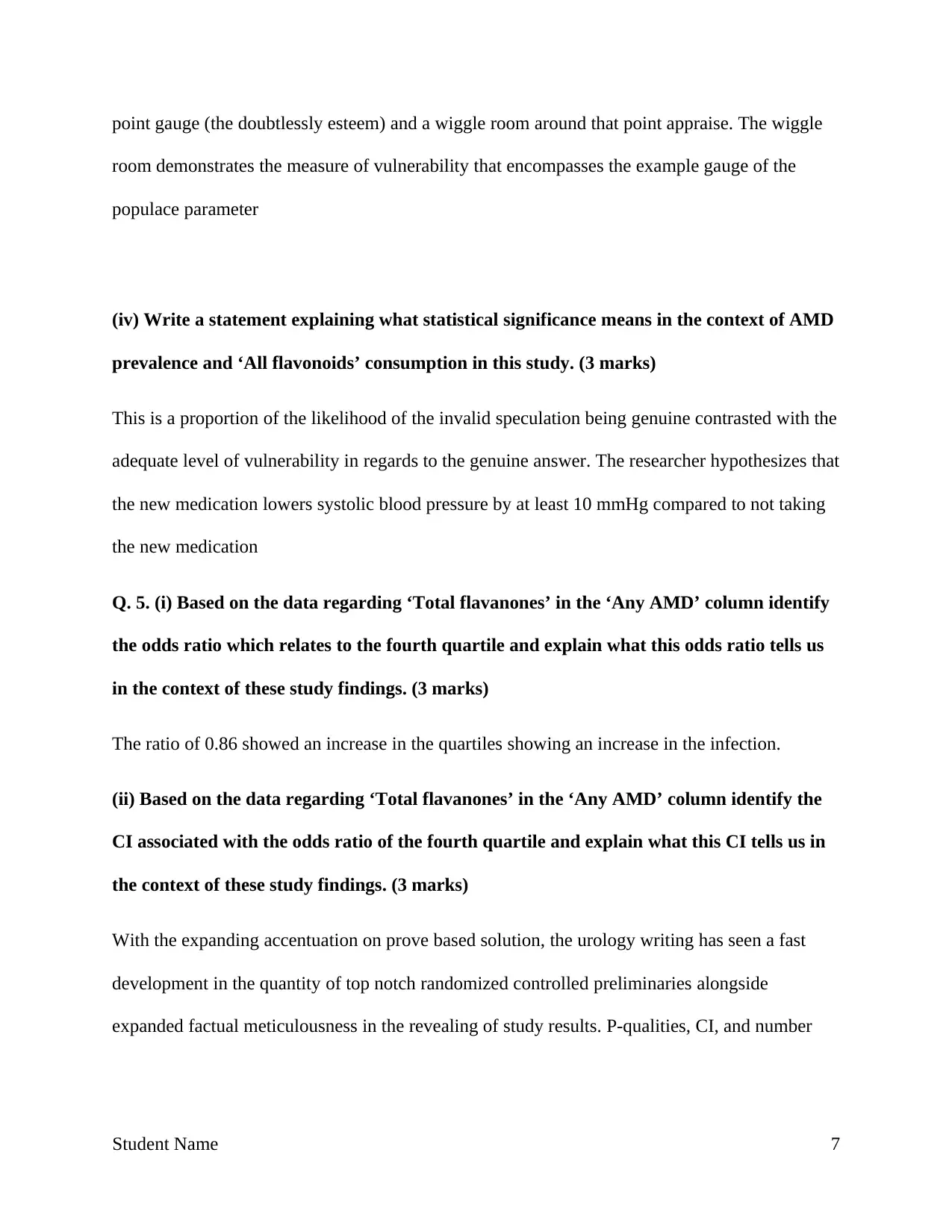
point gauge (the doubtlessly esteem) and a wiggle room around that point appraise. The wiggle
room demonstrates the measure of vulnerability that encompasses the example gauge of the
populace parameter
(iv) Write a statement explaining what statistical significance means in the context of AMD
prevalence and ‘All flavonoids’ consumption in this study. (3 marks)
This is a proportion of the likelihood of the invalid speculation being genuine contrasted with the
adequate level of vulnerability in regards to the genuine answer. The researcher hypothesizes that
the new medication lowers systolic blood pressure by at least 10 mmHg compared to not taking
the new medication
Q. 5. (i) Based on the data regarding ‘Total flavanones’ in the ‘Any AMD’ column identify
the odds ratio which relates to the fourth quartile and explain what this odds ratio tells us
in the context of these study findings. (3 marks)
The ratio of 0.86 showed an increase in the quartiles showing an increase in the infection.
(ii) Based on the data regarding ‘Total flavanones’ in the ‘Any AMD’ column identify the
CI associated with the odds ratio of the fourth quartile and explain what this CI tells us in
the context of these study findings. (3 marks)
With the expanding accentuation on prove based solution, the urology writing has seen a fast
development in the quantity of top notch randomized controlled preliminaries alongside
expanded factual meticulousness in the revealing of study results. P-qualities, CI, and number
Student Name 7
room demonstrates the measure of vulnerability that encompasses the example gauge of the
populace parameter
(iv) Write a statement explaining what statistical significance means in the context of AMD
prevalence and ‘All flavonoids’ consumption in this study. (3 marks)
This is a proportion of the likelihood of the invalid speculation being genuine contrasted with the
adequate level of vulnerability in regards to the genuine answer. The researcher hypothesizes that
the new medication lowers systolic blood pressure by at least 10 mmHg compared to not taking
the new medication
Q. 5. (i) Based on the data regarding ‘Total flavanones’ in the ‘Any AMD’ column identify
the odds ratio which relates to the fourth quartile and explain what this odds ratio tells us
in the context of these study findings. (3 marks)
The ratio of 0.86 showed an increase in the quartiles showing an increase in the infection.
(ii) Based on the data regarding ‘Total flavanones’ in the ‘Any AMD’ column identify the
CI associated with the odds ratio of the fourth quartile and explain what this CI tells us in
the context of these study findings. (3 marks)
With the expanding accentuation on prove based solution, the urology writing has seen a fast
development in the quantity of top notch randomized controlled preliminaries alongside
expanded factual meticulousness in the revealing of study results. P-qualities, CI, and number
Student Name 7
Paraphrase This Document
Need a fresh take? Get an instant paraphrase of this document with our AI Paraphraser
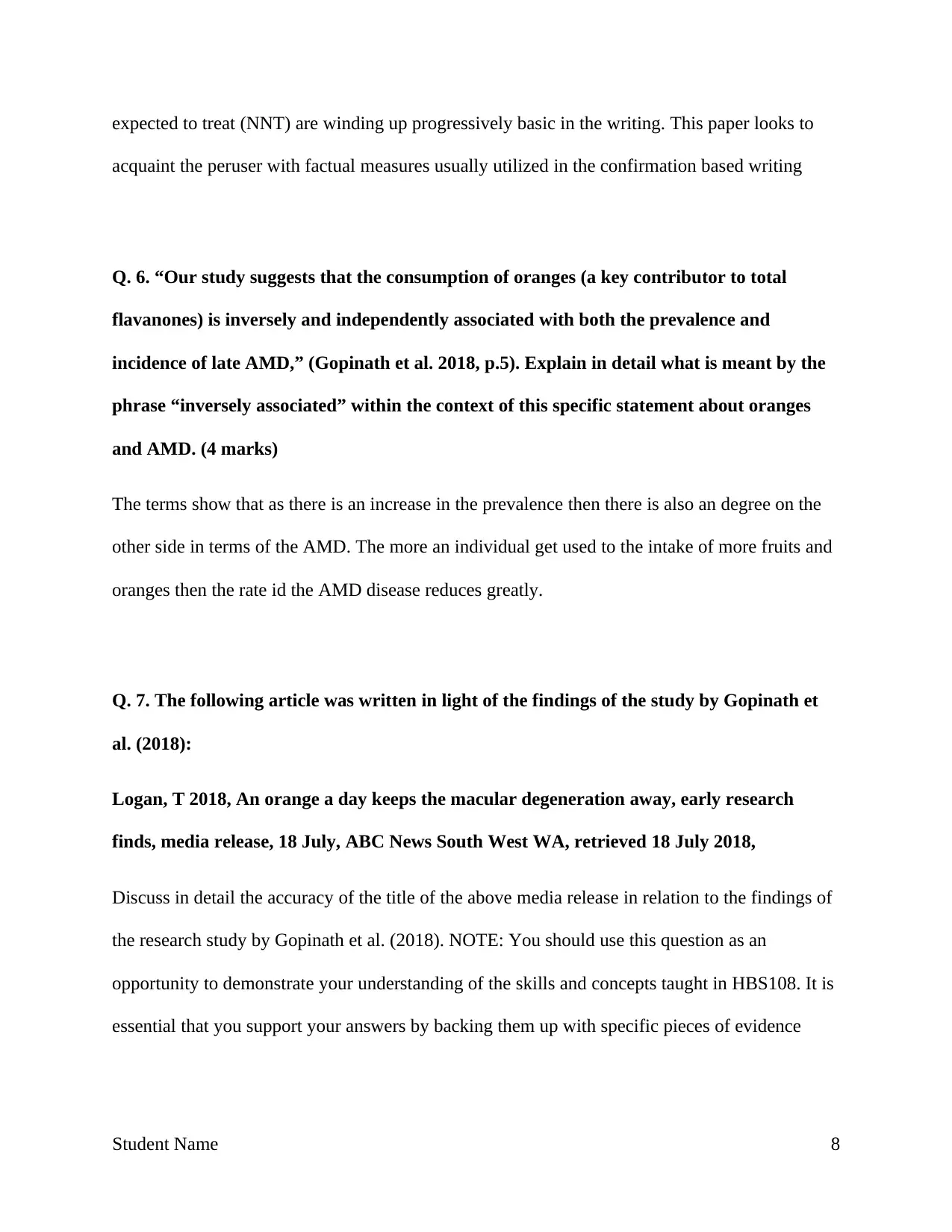
expected to treat (NNT) are winding up progressively basic in the writing. This paper looks to
acquaint the peruser with factual measures usually utilized in the confirmation based writing
Q. 6. “Our study suggests that the consumption of oranges (a key contributor to total
flavanones) is inversely and independently associated with both the prevalence and
incidence of late AMD,” (Gopinath et al. 2018, p.5). Explain in detail what is meant by the
phrase “inversely associated” within the context of this specific statement about oranges
and AMD. (4 marks)
The terms show that as there is an increase in the prevalence then there is also an degree on the
other side in terms of the AMD. The more an individual get used to the intake of more fruits and
oranges then the rate id the AMD disease reduces greatly.
Q. 7. The following article was written in light of the findings of the study by Gopinath et
al. (2018):
Logan, T 2018, An orange a day keeps the macular degeneration away, early research
finds, media release, 18 July, ABC News South West WA, retrieved 18 July 2018,
Discuss in detail the accuracy of the title of the above media release in relation to the findings of
the research study by Gopinath et al. (2018). NOTE: You should use this question as an
opportunity to demonstrate your understanding of the skills and concepts taught in HBS108. It is
essential that you support your answers by backing them up with specific pieces of evidence
Student Name 8
acquaint the peruser with factual measures usually utilized in the confirmation based writing
Q. 6. “Our study suggests that the consumption of oranges (a key contributor to total
flavanones) is inversely and independently associated with both the prevalence and
incidence of late AMD,” (Gopinath et al. 2018, p.5). Explain in detail what is meant by the
phrase “inversely associated” within the context of this specific statement about oranges
and AMD. (4 marks)
The terms show that as there is an increase in the prevalence then there is also an degree on the
other side in terms of the AMD. The more an individual get used to the intake of more fruits and
oranges then the rate id the AMD disease reduces greatly.
Q. 7. The following article was written in light of the findings of the study by Gopinath et
al. (2018):
Logan, T 2018, An orange a day keeps the macular degeneration away, early research
finds, media release, 18 July, ABC News South West WA, retrieved 18 July 2018,
Discuss in detail the accuracy of the title of the above media release in relation to the findings of
the research study by Gopinath et al. (2018). NOTE: You should use this question as an
opportunity to demonstrate your understanding of the skills and concepts taught in HBS108. It is
essential that you support your answers by backing them up with specific pieces of evidence
Student Name 8

from the results and discussion sections of the research study. At least three and distinct well
explained reasons must be provided as a rationale for this answer. (9 marks)
The use of orange protect people from the development of muscular degeneration.
Q. 8. Apply the Bradford-Hill test to identify if causation could be a possibility based on
this study between dietary flavonoids and AMD. For this question you should provide a
very detailed response Page 4 of 6 to each of the criteria/questions of the Bradford-Hill test
using specific information from the study to support each of your responses. (20 marks)
This basis is still exceptionally suitable for deciding causal connections; notwithstanding,
information combination rehearses have prompted a development in thought on what constitutes
consistency. The idea of information combination indeed is intrinsically powerful in elucidation
of whole the consistency foundation as it addresses clear overview a steady tale over numerous
controls and or the practices. For instance, through the viewpoint of information incorporation,
atomic experimentating can reinforce epidemiologic discoveries by giving steady confirmation to
an unthinking speculation, along these lines diminishing the requirement for reiteration among
various observational investigations. In vitro toxicology ponders that recommend a method of
activity, for example, modified quality articulation can bolster an affiliation found in an
epidemiologic examination, Logan (2018). By incorporating results from different sorts of
studies, investigators can show consistency in the causal story by illuminating distinctive
automated demonstrates along the presentation impacts perspective. This is a fundamentally
more broad clarification of consistency than Hill's one of a kind thought of monotonous
epidemiologic revelations.
Student Name 9
explained reasons must be provided as a rationale for this answer. (9 marks)
The use of orange protect people from the development of muscular degeneration.
Q. 8. Apply the Bradford-Hill test to identify if causation could be a possibility based on
this study between dietary flavonoids and AMD. For this question you should provide a
very detailed response Page 4 of 6 to each of the criteria/questions of the Bradford-Hill test
using specific information from the study to support each of your responses. (20 marks)
This basis is still exceptionally suitable for deciding causal connections; notwithstanding,
information combination rehearses have prompted a development in thought on what constitutes
consistency. The idea of information combination indeed is intrinsically powerful in elucidation
of whole the consistency foundation as it addresses clear overview a steady tale over numerous
controls and or the practices. For instance, through the viewpoint of information incorporation,
atomic experimentating can reinforce epidemiologic discoveries by giving steady confirmation to
an unthinking speculation, along these lines diminishing the requirement for reiteration among
various observational investigations. In vitro toxicology ponders that recommend a method of
activity, for example, modified quality articulation can bolster an affiliation found in an
epidemiologic examination, Logan (2018). By incorporating results from different sorts of
studies, investigators can show consistency in the causal story by illuminating distinctive
automated demonstrates along the presentation impacts perspective. This is a fundamentally
more broad clarification of consistency than Hill's one of a kind thought of monotonous
epidemiologic revelations.
Student Name 9
⊘ This is a preview!⊘
Do you want full access?
Subscribe today to unlock all pages.

Trusted by 1+ million students worldwide
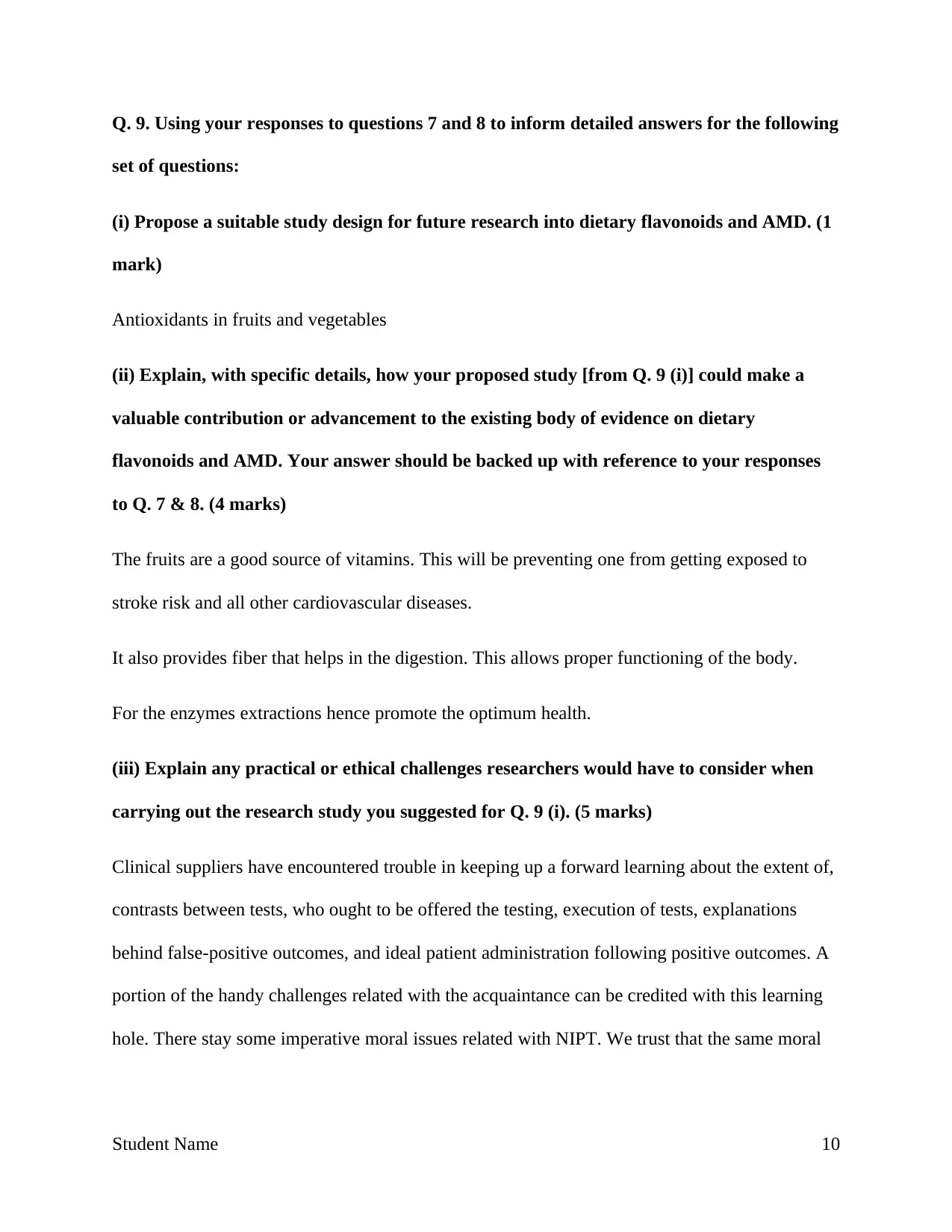
Q. 9. Using your responses to questions 7 and 8 to inform detailed answers for the following
set of questions:
(i) Propose a suitable study design for future research into dietary flavonoids and AMD. (1
mark)
Antioxidants in fruits and vegetables
(ii) Explain, with specific details, how your proposed study [from Q. 9 (i)] could make a
valuable contribution or advancement to the existing body of evidence on dietary
flavonoids and AMD. Your answer should be backed up with reference to your responses
to Q. 7 & 8. (4 marks)
The fruits are a good source of vitamins. This will be preventing one from getting exposed to
stroke risk and all other cardiovascular diseases.
It also provides fiber that helps in the digestion. This allows proper functioning of the body.
For the enzymes extractions hence promote the optimum health.
(iii) Explain any practical or ethical challenges researchers would have to consider when
carrying out the research study you suggested for Q. 9 (i). (5 marks)
Clinical suppliers have encountered trouble in keeping up a forward learning about the extent of,
contrasts between tests, who ought to be offered the testing, execution of tests, explanations
behind false-positive outcomes, and ideal patient administration following positive outcomes. A
portion of the handy challenges related with the acquaintance can be credited with this learning
hole. There stay some imperative moral issues related with NIPT. We trust that the same moral
Student Name 10
set of questions:
(i) Propose a suitable study design for future research into dietary flavonoids and AMD. (1
mark)
Antioxidants in fruits and vegetables
(ii) Explain, with specific details, how your proposed study [from Q. 9 (i)] could make a
valuable contribution or advancement to the existing body of evidence on dietary
flavonoids and AMD. Your answer should be backed up with reference to your responses
to Q. 7 & 8. (4 marks)
The fruits are a good source of vitamins. This will be preventing one from getting exposed to
stroke risk and all other cardiovascular diseases.
It also provides fiber that helps in the digestion. This allows proper functioning of the body.
For the enzymes extractions hence promote the optimum health.
(iii) Explain any practical or ethical challenges researchers would have to consider when
carrying out the research study you suggested for Q. 9 (i). (5 marks)
Clinical suppliers have encountered trouble in keeping up a forward learning about the extent of,
contrasts between tests, who ought to be offered the testing, execution of tests, explanations
behind false-positive outcomes, and ideal patient administration following positive outcomes. A
portion of the handy challenges related with the acquaintance can be credited with this learning
hole. There stay some imperative moral issues related with NIPT. We trust that the same moral
Student Name 10
Paraphrase This Document
Need a fresh take? Get an instant paraphrase of this document with our AI Paraphraser

and lawful rules that were considered in the legitimization of traditional pre-birth screening can
be utilized to evaluate the propriety of extra NIPT applications.
References
Gopinath, B, Liew, G, Kifley, A, Flood, V, Joachim, N, Lewis, J, Hodgson, J & Mitchell, P
2018, ‘Dietary flavonoids and the prevalence and 15-y incidence of age-related macular
degeneration’, The American Journal of Clinical Nutrition, vol. 108, pp. 1–7.
Logan, T 2018, An orange a day keeps the macular degeneration away, early research finds,
media release, 18 July, ABC News South West WA, retrieved 18 July 2018,
<http://www.abc.net.au/news>.
Bibliography
Bischoff-Ferrari, H.A., Willett, W.C., Wong, J.B., Stuck, A.E., Staehelin, H.B., Orav, E.J., Thoma, A., Kiel,
D.P. and Henschkowski, J., 2009. Prevention of nonvertebral fractures with oral vitamin D and dose
dependency: a meta-analysis of randomized controlled trials. Archives of internal medicine, 169(6),
pp.551-561.
Bond, G.R., Drake, R.E. and Becker, D.R., 2008. An update on randomized controlled trials of evidence-
based supported employment. Psychiatric rehabilitation journal, 31(4), p.280.
Collins, L.M. and Lanza, S.T., 2010. Latent class and latent transition analysis: With applications in the
social, behavioral, and health sciences (Vol. 718). John Wiley & Sons.
Lewis, S., 2015. Qualitative inquiry and research design: Choosing among five approaches. Health
promotion practice, 16(4), pp.473-475.
Student Name 11
be utilized to evaluate the propriety of extra NIPT applications.
References
Gopinath, B, Liew, G, Kifley, A, Flood, V, Joachim, N, Lewis, J, Hodgson, J & Mitchell, P
2018, ‘Dietary flavonoids and the prevalence and 15-y incidence of age-related macular
degeneration’, The American Journal of Clinical Nutrition, vol. 108, pp. 1–7.
Logan, T 2018, An orange a day keeps the macular degeneration away, early research finds,
media release, 18 July, ABC News South West WA, retrieved 18 July 2018,
<http://www.abc.net.au/news>.
Bibliography
Bischoff-Ferrari, H.A., Willett, W.C., Wong, J.B., Stuck, A.E., Staehelin, H.B., Orav, E.J., Thoma, A., Kiel,
D.P. and Henschkowski, J., 2009. Prevention of nonvertebral fractures with oral vitamin D and dose
dependency: a meta-analysis of randomized controlled trials. Archives of internal medicine, 169(6),
pp.551-561.
Bond, G.R., Drake, R.E. and Becker, D.R., 2008. An update on randomized controlled trials of evidence-
based supported employment. Psychiatric rehabilitation journal, 31(4), p.280.
Collins, L.M. and Lanza, S.T., 2010. Latent class and latent transition analysis: With applications in the
social, behavioral, and health sciences (Vol. 718). John Wiley & Sons.
Lewis, S., 2015. Qualitative inquiry and research design: Choosing among five approaches. Health
promotion practice, 16(4), pp.473-475.
Student Name 11

Mozaffarian, D., Micha, R. and Wallace, S., 2010. Effects on coronary heart disease of increasing
polyunsaturated fat in place of saturated fat: a systematic review and meta-analysis of randomized
controlled trials. PLoS medicine, 7(3), p.e1000252.
Smith, P.J., Blumenthal, J.A., Hoffman, B.M., Cooper, H., Strauman, T.A., Welsh-Bohmer, K., Browndyke,
J.N. and Sherwood, A., 2010. Aerobic exercise and neurocognitive performance: a meta-analytic review
of randomized controlled trials. Psychosomatic medicine, 72(3), p.239.
Young, T., Finn, L., Peppard, P.E., Szklo-Coxe, M., Austin, D., Nieto, F.J., Stubbs, R. and Hla, K.M.,
2008. Sleep disordered breathing and mortality: eighteen-year follow-up of the Wisconsin sleep
cohort. Sleep, 31(8), pp.1071-1078.
Student Name 12
polyunsaturated fat in place of saturated fat: a systematic review and meta-analysis of randomized
controlled trials. PLoS medicine, 7(3), p.e1000252.
Smith, P.J., Blumenthal, J.A., Hoffman, B.M., Cooper, H., Strauman, T.A., Welsh-Bohmer, K., Browndyke,
J.N. and Sherwood, A., 2010. Aerobic exercise and neurocognitive performance: a meta-analytic review
of randomized controlled trials. Psychosomatic medicine, 72(3), p.239.
Young, T., Finn, L., Peppard, P.E., Szklo-Coxe, M., Austin, D., Nieto, F.J., Stubbs, R. and Hla, K.M.,
2008. Sleep disordered breathing and mortality: eighteen-year follow-up of the Wisconsin sleep
cohort. Sleep, 31(8), pp.1071-1078.
Student Name 12
⊘ This is a preview!⊘
Do you want full access?
Subscribe today to unlock all pages.

Trusted by 1+ million students worldwide
1 out of 12
Your All-in-One AI-Powered Toolkit for Academic Success.
+13062052269
info@desklib.com
Available 24*7 on WhatsApp / Email
![[object Object]](/_next/static/media/star-bottom.7253800d.svg)
Unlock your academic potential
Copyright © 2020–2025 A2Z Services. All Rights Reserved. Developed and managed by ZUCOL.

